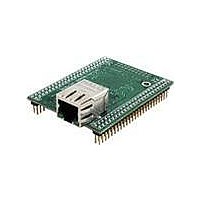MOD5234-100IR NetBurner Inc, MOD5234-100IR Datasheet - Page 481

MOD5234-100IR
Manufacturer Part Number
MOD5234-100IR
Description
MOD5234 10/100 ETHERNET MODULE
Manufacturer
NetBurner Inc
Type
Controllers & Processorsr
Datasheets
1.MOD5272-100IR.pdf
(3 pages)
2.MOD5234-100IR.pdf
(4 pages)
3.MOD5234-100IR.pdf
(754 pages)
Specifications of MOD5234-100IR
Interface
I²C, SPI, UART
Voltage - Supply
2.5V
Mounting Type
Surface Mount
Package / Case
Module
Product
Modules
Lead Free Status / RoHS Status
Lead free / RoHS Compliant
Data Format
-
Baud Rates
-
Lead Free Status / Rohs Status
Lead free / RoHS Compliant
Other names
Q4483564
- Current page: 481 of 754
- Download datasheet (13Mb)
21.4.5 Message Buffer Handling
In order to maintain data coherency and FlexCAN proper operation, the CPU must obey the rules
described in
of CPU accessing a MB structure within FlexCAN other than those specified may cause FlexCAN
to behave in an unpredictable way.
21.4.5.1 Serial Message Buffers (SMBs)
To allow double buffering of messages, the FlexCAN has two shadow buffers called serial
message buffers. These two buffers are used by the FlexCAN for buffering both received messages
and messages to be transmitted. Only one SMB is active at a time, and its function depends upon
the operation of the FlexCAN at that time. At no time does the user have access to or visibility of
these two buffers.
21.4.5.2 Message Buffer Deactivation
If the CPU wants to change the function of an active MB, the recommended procedure is to put
the module into freeze mode and then change the CODE field of that MB. This is a safe procedure
because the FlexCAN waits for pending CAN bus and MB moving activities to finish before
entering freeze mode. Nevertheless, a mechanism is provided to maintain data coherence when the
CPU writes to the Control and Status word of active MBs out of freeze mode.
Any CPU write access to the C/S word of an MB causes that MB to be excluded from the transmit
or receive processes during the current matching or arbitration round. This mechanism is called
MB deactivation. It is temporary, affecting only for the current match/arbitration round.
The purpose of deactivation is data coherency. The match/arbitration process scans the MBs to
decide which MB to transmit or receive. If the CPU updates the MB in the middle of a match or
arbitration process, the data of that MB may no longer be coherent, therefore that MB is
deactivated.
Even with the coherence mechanism described above, writing to the C/S word of active MBs when
not in freeze mode may produce undesirable results. Examples are:
Freescale Semiconductor
• Matching and arbitration are one-pass processes. If MBs are deactivated after they are
• If a Tx MB containing the lowest ID is deactivated after the FlexCAN has scanned it, then
scanned, no re-evaluation is done to determine a new match/winner. If an Rx MB with a
matching ID is deactivated during the matching process after it was scanned, then this MB
is marked as invalid to receive the frame, and FlexCAN will keep looking for another
matching MB within the ones it has not scanned yet. If it can not find one, then the message
will be lost. Suppose, for example, that two MBs have a matching ID to a received frame,
and the user deactivated the first matching MB after FlexCAN has scanned the second. The
received frame will be lost even if the second matching MB was “free to receive”.
the FlexCAN will look for another winner within the MBs that it has not yet scanned.
Section 21.4.1, “Transmit
MCF5235 Reference Manual, Rev. 2
Process” and
Section 21.4.3, “Receive
Process.” Any form
Functional Overview
21-27
Related parts for MOD5234-100IR
Image
Part Number
Description
Manufacturer
Datasheet
Request
R

Part Number:
Description:
MCU, MPU & DSP Development Tools MOD5234 MODULE
Manufacturer:
NetBurner Inc
Datasheet:

Part Number:
Description:
MCU, MPU & DSP Development Tools MOD5234 Core Module Development Kit
Manufacturer:
NetBurner Inc
Datasheet:

Part Number:
Description:
BOARD SERIAL-ETHERNET 512K FLASH
Manufacturer:
NetBurner Inc
Datasheet:

Part Number:
Description:
PROCESSOR MODULE FLASH MOD5272
Manufacturer:
NetBurner Inc
Datasheet:

Part Number:
Description:
PROCESSOR MODULE 512KB FLASH
Manufacturer:
NetBurner Inc
Datasheet:

Part Number:
Description:
DUAL PORT SERIAL-ETHERNET
Manufacturer:
NetBurner Inc
Datasheet:

Part Number:
Description:
PROCESSOR MODULE FLASH
Manufacturer:
NetBurner Inc
Datasheet:

Part Number:
Description:
PROCESSOR MODULE 512KB FLASH
Manufacturer:
NetBurner Inc
Datasheet:

Part Number:
Description:
KIT DEVELOP NETWORK FOR MOD5282
Manufacturer:
NetBurner Inc
Datasheet:

Part Number:
Description:
KIT DEVELOP NETWORK FOR MOD5272
Manufacturer:
NetBurner Inc
Datasheet:

Part Number:
Description:
DUAL PORT SERIAL-ETHERNET
Manufacturer:
NetBurner Inc
Datasheet:

Part Number:
Description:
Ethernet Modules & Development Tools 32 Bit 66MHz 40 Pin DIP Industrial Temp
Manufacturer:
NetBurner Inc
Datasheet:

Part Number:
Description:
Ethernet ICs 32bit 147MHz CAN-to- Ethnt Device IndTemp
Manufacturer:
NetBurner Inc
Datasheet:










